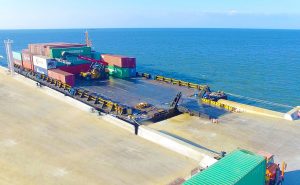CONTAINERIZED goods shipped via barge and domestic vessels must now be registered with the Electronic Tracking of Containerized Cargo (E-TRACC) System, the Bureau of Customs (BoC) said.
Customs Memorandum Order (CMO) No. 09-2024 details the rules for registering cargoes transiting via barge or domestic vessel with E-TRACC.
It also includes the rules for containers entering freeport zones as well as those for export.
This expands CMO 04-2020 and CMO 15-2023, which only covered the inland movement of containerized goods.
Launched in 2020, E-TRACC monitors in real time the movement of containerized goods using a global positioning system (GPS)-enabled tracking device.
The objective is to “generate real time and accurate information and to monitor the movement and location of containers using tracking devices and linking it in real time with the electronic documentation system.”
Containers loaded onto the barge or domestic vessel will only be covered by one booking, according to the bureau.
After the barge or domestic vessel completes its voyage, the authorized representative can immediately book for the transfer of individual containers from the terminal facility to a final destination in a special economic zone, the BoC said, in line with booking procedures set out under CMO 04-2020.
“The import containers shall remain at the terminal facility yard until these laden boxes are booked by their importer or authorized representative. Only booked containers will be sealed with an Electronic Customs Seal and allowed to commence transit to their Special Economic Zone destination.”
Meanwhile, the transfer of containers from the zone to the terminal facility for export must also be booked via the E-TRACC system under CMO 04-2020.
Once at the terminal facility, the customs officer must remove the Electronic Customs Seal before the authorized personnel can book a barge.
“No laden containers shall be allowed to be released/discharged by the terminal facility without the official documents and authorizations from the bureau,” according to the order.
At the transit terminal facility, laden containers with transit cargoes cannot be opened, nor be subjected to a physical examination, it said. Stuffing or stripping of cargoes at the facility are also not allowed.
Ingress and egress of empty containers will only be checked at the transit terminal facility, the BoC added. If there are changes in the mode of travel , a new booking would be required under the E-TRACC system.
The E-TRACC service provider is tasked with ensuring that the system is updated to monitor the movement of containerized goods, BoC said.
It must also create corridors and routes for transit to and from the Manila South Harbor and Tanza Container Terminal, Inc., and from the latter to the Cavite Economic Zones one and two and vice versa.
Terminal facilities handling barge transfers should provide a suitable office for assigned Customs officers, pay the appropriate fees, and ensure stable internet access.
Export groups have called E-TRACC redundant and an unnecessary expense, as their logistics providers already track cargoes via GPS. — Beatriz Marie D. Cruz
